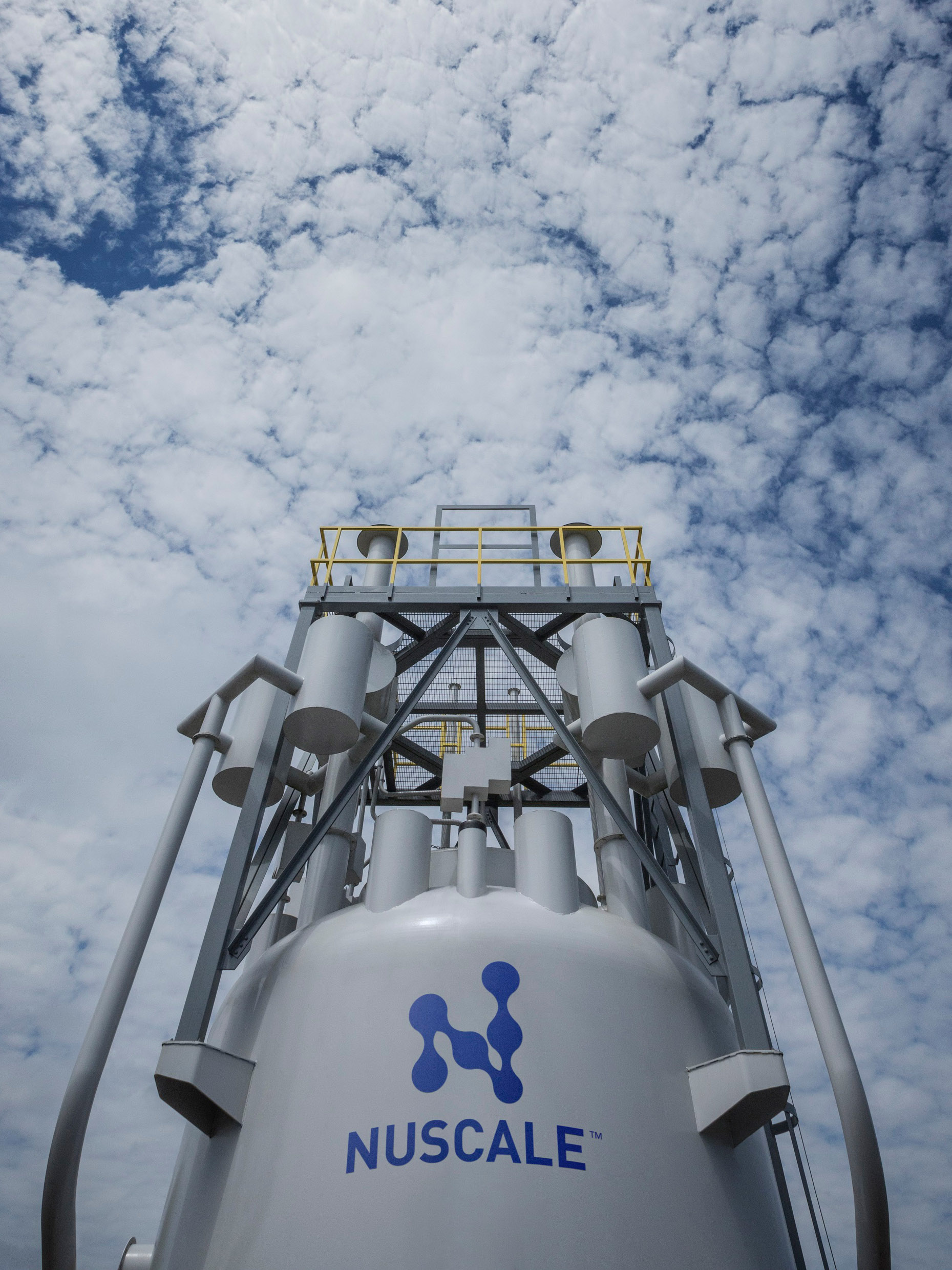2023 Climate Tech Companies to Watch: NuScale and its modular nuclear reactors
The company’s approach could put nuclear power within reach of many more communities.

Explore the 2023 list of 15 Climate Tech Companies to Watch.
NuScale is hoping to revitalize the moribund nuclear power industry with safe and affordable small modular reactors. And with a fresh stamp of approval from the US Nuclear Regulatory Commission, the company plans to break ground in 2025.
Intro
Fission is the grandfather of carbon-free energy, powering 300,000 US homes in the 1950s when photovoltaics were still just lab experiments. Decades of growth were followed by decades of decline, as accidents, waste, and the sheer expense of building nuclear reactors made them commercially and politically toxic.
In 2002, researchers at Oregon State University saw a path to take existing light-water reactors and shrink them by 99%, creating much simpler reactors that would rely on passive cooling—ensuring the reactor’s safety even without external water or power. Five years later, they founded NuScale to commercialize the technology. Their first full-scale reactor, a six-pack of NuScale’s power modules generating nearly 500 megawatts (enough to power around 250,000 average US homes), now looks to be just around the corner.
Key indicators
- Industry: Nuclear energy
- Founded: 2007
- Headquarters: Portland, Oregon, USA
- Notable fact: NuScale’s reactors will have underground pools of water large enough to keep them cool indefinitely and avoid a meltdown should the facility ever lose power.
Potential for impact
Transitioning to a zero-carbon economy will require reliable 24/7 baseload energy to balance out the peaks and troughs of solar, wind, and other renewables. Nuclear fission is well placed to deliver that, and utilities have decades of experience integrating it into regional and national grids.
Today, nuclear provides about a fifth of America’s electricity generation and roughly a tenth of electricity produced worldwide. But as nuclear power stations built decades ago reach the end of their useful lives, relatively few are being replaced. Only two new nuclear reactors have gone online in the US over the last decade, while at least a dozen others have shut down. Globally, the situation is not quite as dire, although closures (108) still outnumber new plants (97) over the last 20 years.
NuScale’s small modular reactors (SMRs) should have price tags in the hundreds of millions of dollars, compared to tens of billions for traditional reactors. If NuScale can prove that these reactors are practical and economically feasible to operate, SMRs could provide a foundation for other sustainable power sources to build on.
Caveats
Although NuScale’s reactors don’t require any fundamentally new science or technology, there are still some big questions ahead. For example, how much will electricity cost? As recently as 2021, NuScale said its first reactors would sell power for $58 per megawatt-hour (MWh). For a project located in Idaho Falls, Idaho, the company’s estimate has since risen to $89/MWh—two or three times the cost of electricity produced by utility-scale solar and wind farms—and the price would be higher still without billions in US federal tax subsidies and a $30/MWh break from last year’s Inflation Reduction Act.
And for NuScale to have a real impact on the climate, it will need to sell a lot of reactors. The US Department of Energy says the US needs up to 770 gigawatts of clean nuclear power to reach net zero by 2050. That equates to over 1,500 SMRs. Are communities ready for a nuclear power station in every midsize town?
When
The US Nuclear Regulatory Commission gave NuScale a big vote of confidence in January, certifying the company’s design for its 50-megawatt power module. That put it years ahead of other startups working on similar designs.
NuScale is now asking regulators to extend that approval to modules that generate 77 megawatts, which would make its reactors more attractive to public utilities. One group of utilities, the Utah Associated Municipal Power Systems, is now working with NuScale to build the company’s first six-pack of modules at the Idaho National Laboratory, home to much fission research in the US. Construction should begin in 2025, with the first module coming online in 2029.
Next steps
As well as building the reactors themselves, NuScale will have to sell the power it produces. As of March, the Utah power companies had committed to purchasing only about a quarter of the reactors' generating capacity. Finding additional buyers could be made more difficult if costs continue to spiral, as tends to happen with nuclear projects. (The two new reactors that have recently opened in the US were $17 billion over budget.)
NuScale is also looking further afield. Romania hopes to secure its own six-pack reactor to replace an old coal-fired power station, with the help of the US Export-Import Bank. That project would likely open after the Idaho facility.
Explore the 2023 list of 15 Climate Tech Companies to Watch.
Correction: This story was updated to more accurately reflect NuScale’s cost estimate for the power it sells.
Deep Dive
Climate change and energy

This rare earth metal shows us the future of our planet’s resources
The story of neodymium reveals many of the challenges we’ll likely face across the supply chain in the coming century and beyond.

Andrew Ng’s new model lets you play around with solar geoengineering to see what would happen
The climate emulator invites you to explore the controversial climate intervention. I gave it a whirl.

Want to understand the future of technology? Take a look at this one obscure metal.
Here’s what neodymium can tell us about the next century of material demand.
Stay connected
Get the latest updates from
MIT Technology Review
Discover special offers, top stories, upcoming events, and more.
